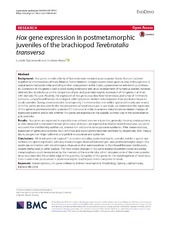| dc.description.abstract | Background: Hox genes encode a family of homeodomain containing transcription factors that are clustered together on chromosomes of many Bilateria. Some bilaterian lineages express these genes during embryogenesis in spatial and/or temporal order according to their arrangement in the cluster, a phenomenon referred to as collinearity. Expression of Hox genes is well studied during embryonic and larval development of numerous species; however, relatively few studies focus on the comparison of pre- and postmetamorphic expression of Hox genes in animals with biphasic life cycle. Recently, the expression of Hox genes was described for embryos and larvae of Terebratalia transversa, a rhynchonelliformean brachiopod, which possesses distinct metamorphosis from planktonic larvae to sessile juveniles. During premetamorphic development, T. transversa does not exhibit spatial collinearity and several of its Hox genes are recruited for the morphogenesis of novel structures. In our study, we determined the expression of Hox genes in postmetamorphic juveniles of T. transversa in order to examine metamorphosis-related changes of expression patterns and to test whether Hox genes are expressed in the spatially collinear way in the postmetamorphic juveniles. Results: Hox genes are expressed in a spatially non-collinear manner in juveniles, generally showing similar patterns as ones observed in competent larvae: genes labial and post1 are expressed in chaetae-related structures, sex combs reduced in the shell-forming epithelium, whereas lox5 and lox4 in dorso-posterior epidermis. After metamorphosis, expression of genes proboscipedia, hox3, deformed and antennapedia becomes restricted to, respectively, shell musculature, prospective hinge rudiments and pedicle musculature and epidermis. Conclusions: All developmental stages of T. transversa, including postmetamorphic juveniles, exhibit a spatial non-collinear Hox genes expression with only minor changes observed between pre- and postmetamorphic stages. Our results are concordant with morphological observation that metamorphosis in rhynchonelliformean brachiopods, despite being rapid, is rather gradual. The most drastic changes in Hox gene expression patterns observed during metamorphosis could be explained by the inversion of the mantle lobe, which relocates some of the more posterior larval structures into the anterior edge of the juveniles. Co-option of Hox genes for the morphogenesis of novel structures is even more pronounced in postmetamorphic brachiopods when compared to larvae. | en_US |

